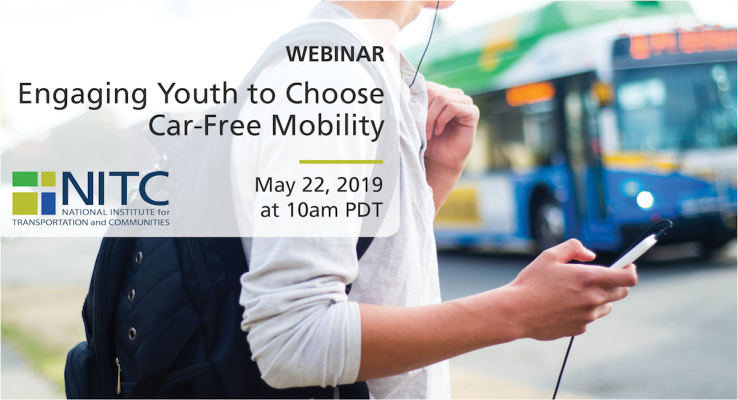The video begins at 1:20.
View slides: Foster Presentation (PDF)
View slides: Muhs Presentation (PDF)
View slides: Wagner Presentation (PDF)
Summaries:
Evaluating Driver and Pedestrian Behaviors at Enhanced Multilane Midblock Pedestrian Crossings: Case Study in Portland, Oregon This study examines driver and pedestrian behaviors at two enhanced midblock pedestrian crossings in Portland, Oregon. One crossing is on a five-lane arterial with a posted speed of 35/45 miles-per-hour (MPH) and features six rectangular rapid flash beacon (RRFB) assemblies and a narrow median refuge. The other crossing is on a suburban arterial with four travel lanes and a two-way left-turn lane. The crossing is enhanced with four RRFB assemblies and a median island with a “Z” crossing, or Danish offset, designed to encourage pedestrians to face oncoming traffic before completing the second stage of their crossing. Approximately 62 hours of video have been collected at the two locations. A total of 351 pedestrian crossings are analyzed for driver compliance (yielding) rates, pedestrian...
Read moreThe video begins at 2:58.
Abstract: While TriMet and other transit agencies serve many commuters by having racks for bikes on trains and buses, large bike parking facilities in global capitals of urban bicycling provide the key link between bikes and transit. Following the lead of European and Asian cities, the Portland region is starting to develop a network of bike-transit facilities; TriMet is piloting smart bike parking technology in the form of electronic bike lockers and "Bike & Rides". This presentation discusses the background and planning for bike-transit integration in the region and shares insights into bike-transit travel patterns, habits, and market segmentation gained from recent rider surveys.
View slides
Watch video:
Jerusalem is perhaps an extreme case of residential and travel market segmentation. It is comprised of four different 'cities', which partially overlap in space: The Jewish-Zionist city; the Palestinian city; the Jewish ultra-orthodox city and the global-tourist city. While the specific delineation of these cities is unique, Jerusalem can be seen as representative...
Read morePRESENTATION ARCHIVE
Miss the webinar or want a look back?
OVERVIEW
Today’s youth are tomorrow’s riders, bikers, walkers, voters, and transportation planners. As more transit agencies begin to offer free fare passes to public middle and high school students, it is important to have good communication strategy in place to encourage transit usage so they don't miss out on the potential to affect behavior change.
Thus, transit agencies need to develop age-appropriate messaging strategies and tactics that promote youth car-free mobility.
This webinar will present results from a NITC research project that sought to create and evaluate communication messaging that fosters more positive attitudes, intentions, and behaviors related to transit and other car-free transportation options among Portland youth. While there is no "one size fits all" approach, the Portland-based findings may yield insights that could be adapted for application in other regions.
KEY LEARNING OUTCOMES...
Read moreThe video begins at 1:19.
View slides
Summary: Where and when does overcrowding happen on TriMet's bus network? Which routes have the best on-time performance? Portland State University and TriMet have collaborated to make this kind of data available to anybody through Portal, PSU's transportation data archive for the Portland/Vancouver region. This presentation will cover the use of General Transit Feed Specification (GTFS) data for mapping TriMet’s performance data and the development of Portal’s innovative transit application. In the MAP-21 era of performance management, see how tools like Portal can support enhanced agency decision-making as well as community engagement.
Bio: Jon Makler researches and teaches about transportation planning and engineering at Portland State University. His research portfolio centers on intelligent transportation systems, including how they can be harnessed to benefit the environment and how the data they generate can support operational strategies and planning decisions. Since moving to Oregon 9 years ago, he has worked at Metro, the City of Portland and OTREC, the federally-funded research center housed at PSU. His previous employers were the North Jersey Transportation Planning Authority, the Harvard Kennedy School, IBI Group and Sarah...
Read moreThe video begins at 1:26.
Abstract: How do commuter rail riders choose access modes? This presentation discusses the results of an analysis of access mode choice by riders of one of the first U.S. suburb-to-suburb commuter railroads, the Westside Express Service (WES) in the Portland, Oregon metropolitan area. The study uses on-board survey data collected by the region’s transit agency, Tri-Met, during WES’s first year of operation. The data include observed access mode choices, historical mode usage, and subjective assessment of WES attributes. A hierarchical choice model was estimated, using attributes of the access trip and station areas as well as rider characteristics. The estimation results showed evidence of pre-WES mode inertia effects in choosing drive access, pro-sustainability attitudes in choosing bike access, the importance of comfort for light rail and auto access modes, as well as strong positive station-area effects of connecting bus lines and parking space provision. The hierarchical choice model revealed significant substitution effects between drive and light rail modes and between bike and walk modes. This study provides potentially valuable insights to agencies for the purposes of station-area planning and targeted marketing efforts.
View slides
Watch video:
Successful public transit systems increase the value of locations they serve. Capturing this location value to help fund transit is often sensible, but challenging.
This presentation will define location value capture, and synthesize lessons learned from six European and North American transit agencies that have experience with location value capture funding.
The opportunities for and barriers to implementing location value capture fall into three categories:
- agency...

